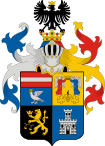Tarcal
Tarcal | ||
|---|---|---|
 Aerial photo of Tarcal | ||
| ||
 Tarcal Location of Tarcal in Hungary | ||
| Coordinates: 48°07′53″N 21°20′34″E / 48.13128°N 21.34267°E / 48.13128; 21.34267Coordinates: 48°07′53″N 21°20′34″E / 48.13128°N 21.34267°E / 48.13128; 21.34267 | ||
| Country | Hungary | |
| Region | Northern Hungary | |
| County | Borsod-Abaúj-Zemplén | |
| Area [1] | ||
| • Total | 53.72 km2 (20.74 sq mi) | |
| Population (2012)[2] | ||
| • Total | 2,824 | |
| • Density | 53/km2 (140/sq mi) | |
| Time zone | UTC+1 (CET) | |
| • Summer (DST) | UTC+2 (CEST) | |
| Postal code | 3915 | |
| Area code | +36 47 | |
| Website | www.tarcal.hu | |
Tarcal is a village on the eastern edge of Borsod-Abaúj-Zemplén county, northern Hungary, in the famous Tokaj-Hegyalja wine district, 55 km (34 mi) from Miskolc.
Contents
1 Geography
2 History
3 Jewish community
4 Sights of Tarcal
5 Images
6 Notes
7 References
Geography
Tarcal is located at 48°07′N 21°25′E / 48.117°N 21.417°E / 48.117; 21.417, at the western foot of the 516 m high Nagy Hill at Tokaj at the southernmost foothills of the Eperjes-Tokaj mountain range..
Tarcal is probably the best grape-growing locale of the world famous Tokaj-Hegyalja wine district. All the traditional Tokaji grape varieties (Furmint, Hárslevelű, Sárga Muskotály (Yellow muscat) grown here dry well on the vine, so they are suitable for excellent vintage wines, special quality Szamorodni wines, and 3-to-6 Puttonyos Tokaji aszú wines. These wines are seasoned in oakwood casks in cellars covered with choice mould (racodium cellare, a noble cellar mould).
History
The estate was presented to Captain Turzul by Árpád at the time of the Conquest.
In 1941 the population of Tarcal was 4004.
During deportations to the USSR in 1945 the local priest János Szerednyei voluntarily agreed to join a group of Tarcal inhabitants rounded up for deportations. He was sent to a labour camp in Vorosilovka, a part of the gulag. Szerednyei died in a coal mine accident in 1948.
In 2015 a 8.5-meter statue of Jezus was displayed on a hill above the village.[3] The sculptor was Sándor Szabó.[4]
Jewish community
The Jewish population in Tarcal was 299 in 1941. Most of the Tarcal Jews perished in the Holocaust in 1944. In 1946 only 30 Jews lived in Tarcal.[5]
Among the famous rabbis of Tarcal were:
- Rabbi Yitzchak Isaac Taub, the first Hasidic Rebbe in Hungary. He later relocated to Nagykálló and remains famous as the Kaliv Rebbe.
- Rabbi Yechezkel Paneth (1813–1822), author of Mare Yeheskel (Marmaros, 1875).
- Rabbi Chayim Yosef Gottlieb (born Tarcal, 1790). In 1823 he was appointed dayan and teacher in Tarcal.
- Rabbi Yaakov Shapira (1876–1906), a famous scholar, often mentioned in the halachic responsa of the famous rabbis of Hungary.
- Rabbi Yehoshua Heshil Rosner (1906–1944). He was the son-in-law of Rabbi Yaakov Shapira. Rabbi Rosner perished in the Holocaust in 1944.
Sights of Tarcal
The architectural sights of the village are mostly connected to the Rákóczi family. The mansions called King court, Rákóczi tavern and Sebeö mansion got their present form at the end of the 18th century.
The Roman Catholic church is from 1615. Its foundations, crypt and the bottom part of the tower are of medieval origin. The Calvinist church, where a memorial tablet commemorates the Reformed Confession, which was created here by the Tarcal Council in 1564, and the oval planned Terézia chapel were built between 1770 and 1790. The renovated synagogue was built in the second half of the 17th century.
Another interesting sight of Tarcal may be the Andrássy Manor, which was built in baroque style in the 16th century. Under the mansion, owned by the Andrássy family for several decades, there is a hidden cellar mainly used for producing and storing wine.
Images

A panorama of Tarcal taken from the Kopasz mountain
Notes
^ Tarcal at the Hungarian Central Statistical Office (Hungarian).
^ Tarcal at the Hungarian Central Statistical Office (Hungarian). 2012
^ http://tarcal.hu/aldo-jezus-szobor/ access 22 July 2015
^ https://www.kozterkep.hu/~/25062/Aldo_Krisztus_Tarcal_2015.html access 22 July 2015
^ . Jewishgen.org http://www.jewishgen.org/yizkor/pinkas_hungary/hun305.html. Retrieved 1 January 2014. Missing or empty|title=(help).mw-parser-output cite.citation{font-style:inherit}.mw-parser-output q{quotes:"""""""'""'"}.mw-parser-output code.cs1-code{color:inherit;background:inherit;border:inherit;padding:inherit}.mw-parser-output .cs1-lock-free a{background:url("//upload.wikimedia.org/wikipedia/commons/thumb/6/65/Lock-green.svg/9px-Lock-green.svg.png")no-repeat;background-position:right .1em center}.mw-parser-output .cs1-lock-limited a,.mw-parser-output .cs1-lock-registration a{background:url("//upload.wikimedia.org/wikipedia/commons/thumb/d/d6/Lock-gray-alt-2.svg/9px-Lock-gray-alt-2.svg.png")no-repeat;background-position:right .1em center}.mw-parser-output .cs1-lock-subscription a{background:url("//upload.wikimedia.org/wikipedia/commons/thumb/a/aa/Lock-red-alt-2.svg/9px-Lock-red-alt-2.svg.png")no-repeat;background-position:right .1em center}.mw-parser-output .cs1-subscription,.mw-parser-output .cs1-registration{color:#555}.mw-parser-output .cs1-subscription span,.mw-parser-output .cs1-registration span{border-bottom:1px dotted;cursor:help}.mw-parser-output .cs1-hidden-error{display:none;font-size:100%}.mw-parser-output .cs1-visible-error{font-size:100%}.mw-parser-output .cs1-subscription,.mw-parser-output .cs1-registration,.mw-parser-output .cs1-format{font-size:95%}.mw-parser-output .cs1-kern-left,.mw-parser-output .cs1-kern-wl-left{padding-left:0.2em}.mw-parser-output .cs1-kern-right,.mw-parser-output .cs1-kern-wl-right{padding-right:0.2em}
References
- [1]
- [2]
Street map (in Hungarian)


